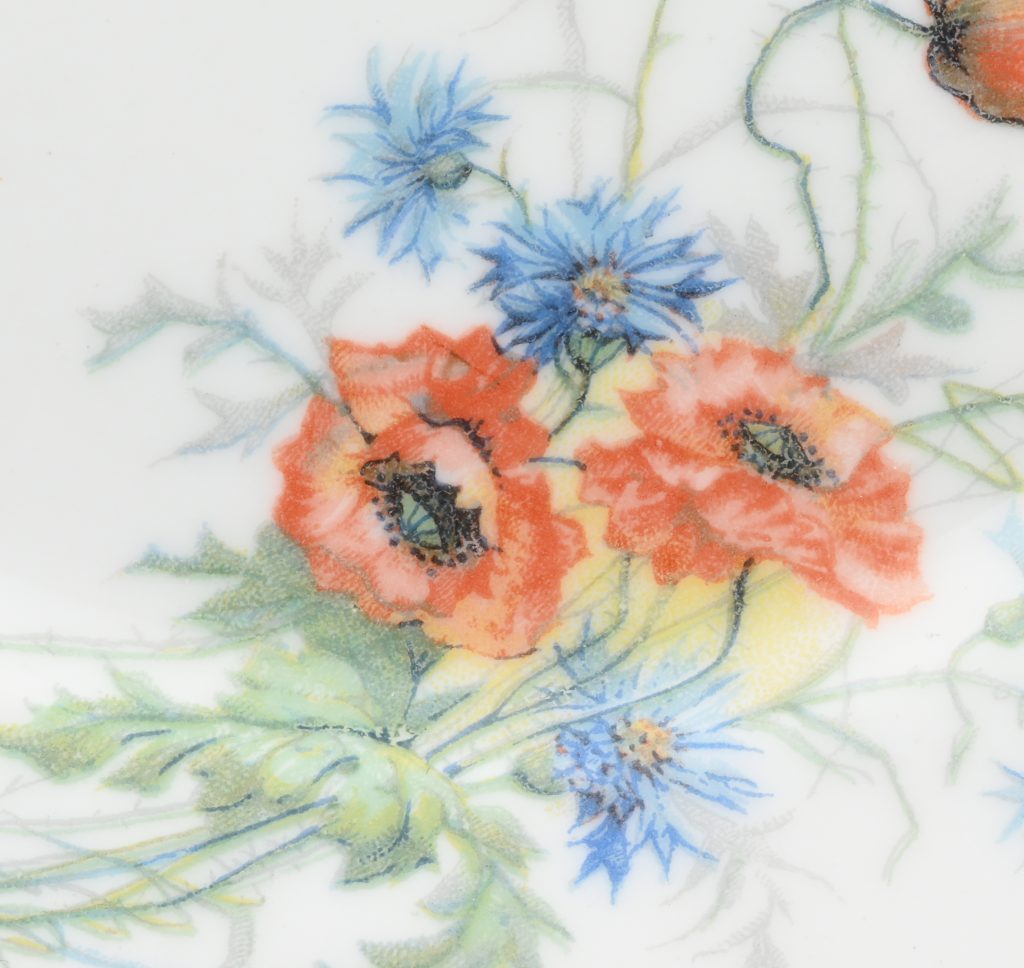
Andreas Heege 2019
Technically these are polychrome lithographs (or chromolithographs). The theory behind the technique was first described in 1818 and systematically developed in subsequent years (English patents in 1835 and 1836, French patent in 1837. On the technique see Zeidler 1994, 84-89; Twyman 2007; Twyman 2013; Last 2005). In chromolithography, a separate printing stone had to be made for each colour. The different stones were then printed onto paper, one over the other, starting with the brightest and ending with the darkest colour. The printed paper was then pressed onto the glazed or unglazed ceramic surface, which had been prepared with a special type of glue. Once the paper had dried onto the vessel, it was wetted and then removed, leaving the printed image on the surface of the pottery. The colour was then fixed by firing. The invention of Duplex paper in 1895 made the technically challenging process easier, thus significantly reducing the overall costs. From 1936, it became possible to coat the right side of the print with a substance that allowed the printed images to be floated off the paper in a water bath and transferred onto the glazed vessel surface. The overglaze colours could then be fixed by firing.
In places like Amberg in the Upper Palatinate, pottery manufacturers were experimenting with chromolithographs from as early as 1860 to 1863 (Endres/Berwing-Wittl/Kleindorfer-Marx 2004, 93). Following initial experiments in the 1850s, lithographic overglaze printing was used in Saargemünd in the 1870s and probably from as early as 1859 in Mettlach (Decker/Hoffmann/Thevenin 1999, 81–85; Decker 2003, 157; Linnemann 2001, 31). In England it became increasingly popular from around 1890 and was used in mass-production from 1900 onwards (Brooks 2005, 36 and Majewski/O´Brien 1987, 146 and 147; Morgenroth 1989, 107 and 108). By contrast to standard transfer (underglaze) prints, chromolithographs were almost always used as overglaze decorations. The technique made the production of pottery with monochrome or polychrome overglaze decoration considerably faster and allowed for larger production runs. Compared to underglaze brushwork decoration, however, overglaze printing produced patterns that were less resistant to abrasion.
Translation Sandy Haemmerle
German: Aufglasur-Druckdekor (Abziehbilddekor)
French: Chromolithographie (procédé d’impression lithographique en couleurs), décalque, Décalcomanie (Procédé qui permet de transporter des images coloriées sur la porcelaine)
References:
Decker 2003
Emile Decker, Une imagerie sur faience : les assiettes parlantes à sujets imprimés de la manufacture de Sarreguemines, in: Jean-Michel Minovez, Faience fine et porcelaine. Les hommes, les objets, les lieux, les techniques, Toulouse 2003, 153-170.
Decker/Hoffmann/Thevenin 1999
Emile Decker/Diana Hoffmann/Christian Thevenin, Des hommes, des terres, des machines. La production de la faience à la manufacture de Sarreguemines, Sarreguemines 1999.
Endres/Berwing-Wittl/Kleindorfer-Marx 2004
Werner Endres/Margit Berwing-Wittl/Bärbel Kleindorfer-Marx, Steingut. Geschirr aus der Oberpfalz, München 2004.
Last 2005
Jay T. Last, The Colour Explosion: Nineteenth-Century American Lithography, Santa Ana, Californien 2005.
Linnemann 1999
Blanka Linnemann, Bildergeschirr. Aspekte einer halbindustriellen Massenware des 19. Jahrhunderts am Beispiel Villeroy&Boch, in: Bärbel Kerkhoff-Hader/Werner Endres (Hrsg.), Keramische Produktion zwischen Handwerk und Industrie, Alltag – Souvenir – Technik, Beiträge zum 31. Internationalen Hafnerei – Symposion des Arbeitskreises für Keramikforschung in Bamberg vom 28. September bis 4. Oktober 1998 (Bamberger Beiträge zur Volkskunde 7), Hildburghausen 1999, 89-100.
Twyman 2007
Michael Twyman, Images en couleur, Godefroy Engelman, Charles Hullmandel et les débuts de la chromolithographie, Paris 2007.
Twyman 2013
Michael Twyman, A History of Chromolithography: Printed Colour for All, London 2013.
Zeidler 1994
Jürgen Zeidler, Lithographie und Steindruck in Gewerbe und Kunst, Technik und Geschichte, Stuttgart 1994.

